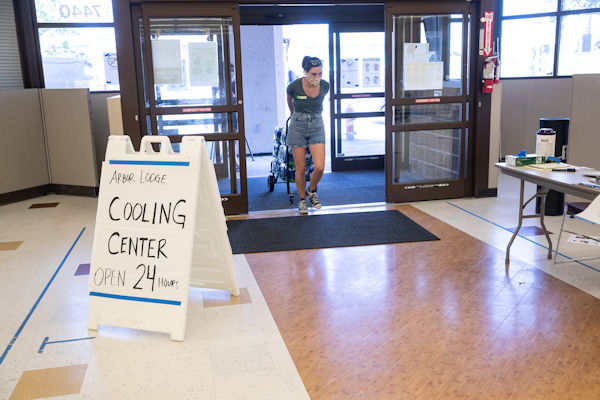SEJournal Online is the digital news magazine of the Society of Environmental Journalists. Learn more about SEJournal Online, including submission, subscription and advertising information.
 |
| The public health toll from extreme heat falls largely on the elderly, children, those who are poor and those who are homeless. Above, a cooling center in Portland, Oregon, in August 2021. Photo: Multnomah County Communications, Flickr Creative Commons (CC BY-NC-ND 2.0). |
Reporter’s Toolbox: Amid Heat Waves, Data on Heat Deaths Deadly Serious
By Joseph A. Davis
A broiling, record-breaking heat dome has settled over much of the North American continent, striking parts of the country where people haven’t hitherto needed air conditioning. And July will possibly be worse than June.
The heat wave isn’t just environmental news — it’s a story about a public health crisis that’s killing people.
Many are surprised to learn that the most deadly extreme weather events are not hurricanes, floods or tornadoes. It’s excess heat.
Extreme heat is a story about how
climate change is especially dangerous
for the most vulnerable.
It’s a story about how climate change is especially dangerous for the most vulnerable: the elderly, the very young, the poor, those addicted to opioids and those without homes.
As a journalist, you’ll want to put some statistics behind those heartbreaking stories. You can start by checking out the U.S. Environmental Protection Agency’s “datapalooza” on its Climate Change Indicators: Heat Waves page.
The page presents the data well. It is documented, shown graphically and contextualized. The only downside might be an emphasis on the national scope, although it does include info about heat waves in 50 large U.S. cities for the last half-century.
Where the data come from
The EPA data on excess heat deaths come from the National Oceanic and Atmospheric Administration — home of the National Weather Service and other agencies with vast stores of instrumental data.
A key problem, though, is how to know whether a person’s death has been caused by excess heat or something else. The death certificate may report a heart attack or dehydration, rather than “heat stroke.”
Some reporters, like those at BuzzFeed News, are helping lead the way in analysis using the “excess deaths” method (which starts with the normal, expected death rate in a population and then compares it to higher numbers of deaths around the time of a particular event). And the excess deaths data shows a higher death toll from heat waves than the official numbers indicate.
You can also find more on the EPA’s Climate Change Indicators: Heat-Related Deaths and Heat-Related Illnesses pages.
How to use the data smartly
As you report on the human consequences of climate change, it would be wise to avoid a numbers-only approach. But if you have the resources, try the excess-death approach for your local area or region.
And it may also be wise to take into account the environmental justice dimension of the issue. Are vulnerable populations, homeless people and those who are poor dying simply because of heat — or because they lack air conditioning, health care and political power?
It might be good, too, to investigate just how geographically fine-grained the consequences of heat events are.
Studies have shown poorer areas of cities, especially those with ethnic and racial groups who have been redlined (may require subscription), are indeed hotter. Whether this is because of more pavement or fewer trees or for other reasons (i.e., racism), it is worth exploring. If you see trends in smaller geographic units, so much the better.
Do not neglect to include the climate change angle. If heat is getting worse, that’s likely the problem.
On the other hand, don’t let the urgency of the need for climate action distort your perspective on the problem. It’s not climate change or homelessness; it’s climate change and homelessness.
[Editor’s Note: For more on this topic, check our Issue Backgrounder on extreme heat and human health, plus past Toolboxes on the related EPA data sources and on National Weather Service observational data. Also see TipSheets on urban heat islands and heat-induced grid failures, and a feature on advances in attribution science that help connect climate change and extreme weather like heat waves. For more on climate change generally, be sure to visit our Climate Change Resource Guide and its collection of resources on human health, as well as our special “Covering Your Climate” reports on the Pacific Northwest and on the South. And keep track of the latest heat wave-related headlines via EJ Today’s top stories and @EJTodayNews on Twitter.]
Joseph A. Davis is a freelance writer/editor in Washington, D.C. who has been writing about the environment since 1976. He writes SEJournal Online's TipSheet, Reporter's Toolbox and Issue Backgrounder, and curates SEJ's weekday news headlines service EJToday and @EJTodayNews. Davis also directs SEJ's Freedom of Information Project and writes the WatchDog opinion column.
* From the weekly news magazine SEJournal Online, Vol. 7, No. 26. Content from each new issue of SEJournal Online is available to the public via the SEJournal Online main page. Subscribe to the e-newsletter here. And see past issues of the SEJournal archived here.













 Advertisement
Advertisement 



